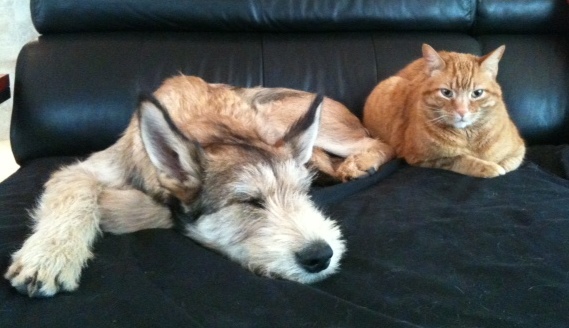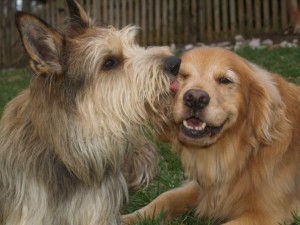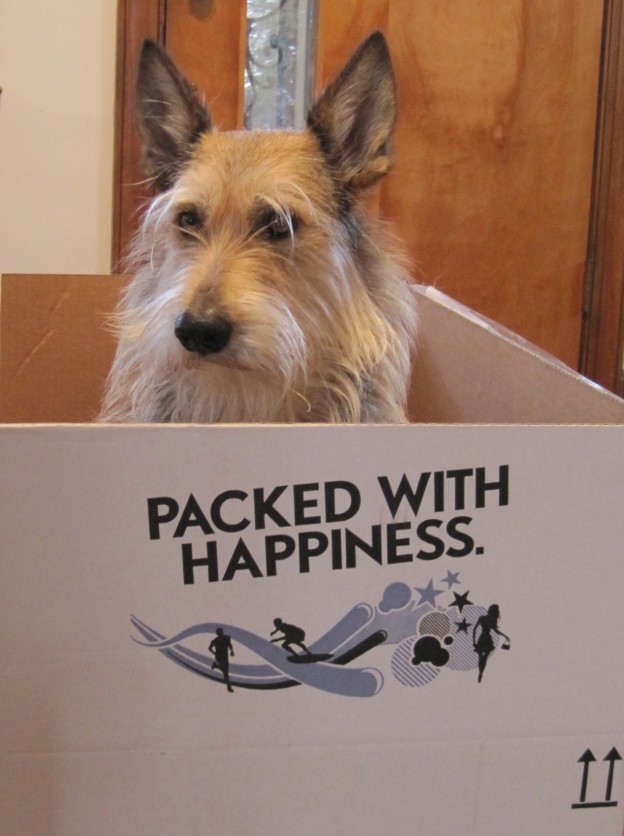Socialize! Socialize! Socialize!
 Like many herding breeds, Picards require human companionship and lots of it. Imagine a shepherd of old sitting out on the French countryside with his flock, looking into the very human eyes of his Picard: Herding breeds are bred to be intelligent, sensitive, one owner dogs. Therefore, they can be aloof, cautious and if not properly socialized, unfriendly to strangers.
Like many herding breeds, Picards require human companionship and lots of it. Imagine a shepherd of old sitting out on the French countryside with his flock, looking into the very human eyes of his Picard: Herding breeds are bred to be intelligent, sensitive, one owner dogs. Therefore, they can be aloof, cautious and if not properly socialized, unfriendly to strangers.
Properly, well socialized Picards are a joy to be around. Although their temperament will never be the same as a typical Golden Retriever, they can and do, for example, make wonderful therapy dogs. They are also very loving towards their family. Consistent, regular socializing into adulthood in various environments such as outings with the family, regular visits in and around places where people frequent, and doggie classes of any kind just to name a few examples, will ensure the Picard a happy and healthy view of the world and the people in it.
Berger Picards are an ancient breed and it is important not to overlook the fact that they are inherently one owner dogs, which does have drawbacks that should be considered. As they get older and if not properly exposed and socialized, Picards can become skittish and unfriendly around strangers. So a wise Picard owner must be intentional about making socialization happen.
Fearful Stages
 Picards, if socialized early, can get along with cats!Picards, during their growth and development, go through 2 basic fearful periods. Before and after these stages, your puppy may be outgoing and demonstrative. But, seemingly without notice, your puppy may become a different animal. Proper socialization during these periods is crucial to how the puppy turns out on the other side.
Picards, if socialized early, can get along with cats!Picards, during their growth and development, go through 2 basic fearful periods. Before and after these stages, your puppy may be outgoing and demonstrative. But, seemingly without notice, your puppy may become a different animal. Proper socialization during these periods is crucial to how the puppy turns out on the other side.
Most puppies are adopted by their new owners at or around 8 weeks. It is imperative prior to the first fearful stage at 14 weeks to expose the puppy to as many new people, places, sounds and situations. Remember to always be positive in your approach, as Picards have a sensitive nature. With each good response, treat handsomely. Play confidence building games like fetch and tug of war. Enroll the puppy in a puppy class at your local kennel club or doggie day care facility.

Around 12 to 14 weeks of age, the puppy will begin the first fearful stage, demonstrated either by fearful aggression (barking) or skittish behavior (hiding). Do not over react by comforting the puppy. However, do not force the puppy to submit to unwanted attention. On the other hand, do reward polite and tolerant behavior with lots of yummy treats. Also, instruct strangers to ignore the puppy if it is not coping with intense socialization. This gives the puppy a moment to decide if the new person can be trusted.
Protecting puppies from interactions with aggressive dogs is important in preventing dog aggression. Picards tend to carry those experiences with them and could react in a fearful or defensive manner when presented with similar situations later on in life. Good tempered, well socialized older dogs are the best teachers, showing the young Picard proper play manners and dog communication.
The second stage begins at around 8-9 months of age as the puppy grows into being an adolescent. Hormones may play a role in this phase. It is key at this time that your puppy does not feel that he needs to protect YOU. Good leadership skills help to convey to your dog that you have the situation under control and your puppy does not need to put his paw in.
Word of Caution
 Although endearing to humans, in dogs, prolonged eye contact is a sign of aggression. Picards have this innate ability whereas most other breeds look away. This however, is the Picard’s nonverbal way to show interest and communicate a connection. So a Picard may be standing and looking just this way to another dog, the other dog however, may perceive the Picard as making aggressive overtures and respond negatively. Picards also have naturally upright, pricked ears. In many other breeds, pricked upright ears are also, to another dog, a sign of aggression. It says the dog is on guard.
Although endearing to humans, in dogs, prolonged eye contact is a sign of aggression. Picards have this innate ability whereas most other breeds look away. This however, is the Picard’s nonverbal way to show interest and communicate a connection. So a Picard may be standing and looking just this way to another dog, the other dog however, may perceive the Picard as making aggressive overtures and respond negatively. Picards also have naturally upright, pricked ears. In many other breeds, pricked upright ears are also, to another dog, a sign of aggression. It says the dog is on guard.
Care should be taken at dog parks, dog classes or other canine events because of this. Watch your dog and how it interacts with other dogs. If the dog stares too long, intervene by standing in its line of vision.
Resources
A plethora of resources are available on socialization for new puppy owners. As with anything in life, the more you know the better prepared you are! Here is just a few!
AKC has a wonderful page devoted to socialization:
Another excellent resource is Ian Dunbar’s book, Before and After Getting a Puppy. This is available for purchase on line and in the an abridged form for free here:
